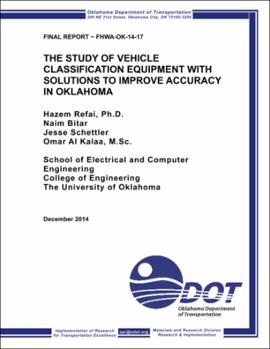| dc.creator | Refai, Hazem | |
| dc.creator | Naim, Bitar | |
| dc.creator | Schettler, Jesse | |
| dc.creator | Kalaa, Omar Al | |
| dc.date.accessioned | 2017-12-20T23:13:18Z | |
| dc.date.available | 2017-12-20T23:13:18Z | |
| dc.date.issued | 2014-12 | |
| dc.identifier.govdoc | FHWA-OK-14-17 | |
| dc.identifier.other | Oklahoma Department of Transportation State Planning and Research item number 2250 | |
| dc.identifier.uri | https://hdl.handle.net/11244/54277 | |
| dc.description.abstract | The accuracy of vehicle counting and classification data is vital for appropriate future highway and road design, including determining pavement characteristics, eliminating traffic jams, and improving safety. Organizations relying on vehicle classifiers for data collection should be aware that systems can be affected by hardware and sensor malfunction, as well as the equipmentÍs implementation of classification scheme (i.e., algorithm). This report presents outcomes from an extensive statewide examination of vehicle misclassification at Oklahoma Department of Transportation (ODOT) AVC stations employing the PEEK Traffic 'FHWA-USA' classification algorithm. A ground truth system utilizing continuous video recordings was developed and utilized. Results from the rigorous investigation are reported herein. Also detailed in this report is a novel method for an improved classification algorithm designed to reduce the number of classification errors. Thirteen Gaussian distributions were employed to model axle spacing for each of the 13 FHWA vehicle types. Classifications obtained from video recordings and PEEK Traffic axle spacing measurements for a sample of 20,000 vehicles were recorded and analyzed to obtain 13 good-fit Gaussian distributions that correspond with each vehicle class. An optimization algorithm was then implemented to develop axle spacing thresholds for vehicles currently traveling Oklahoma's highways and to minimize vehicle misclassification. The new scheme was then implemented in the PEEK Traffic automatic data record equipment and experimentally evaluated for accuracy. Results demonstrated its effectiveness in improving vehicle classifications and reducing persistent overall system errors characteristic of the 'FHWA-USA' Scheme. Analysis methodology detailed in this report will benefit organizations interested in improving vehicle classification and overall system accuracy. | |
| dc.format.extent | 104 pages | |
| dc.format.extent | 2,807,081 bytes | |
| dc.format.medium | application.pdf | |
| dc.language | en_US | |
| dc.publisher | Oklahoma City, OK : Oklahoma Department of Transportation, 2014. | |
| dc.relation.ispartofseries | No | |
| dc.relation.requires | Adobe Acrobat Reader | |
| dc.relation.uri | http://www.okladot.state.ok.us/Research/FinalRep_2250_FHWA-OK-14-17.pdf | |
| dc.title | The Study of Vehicle Classification Equipment with Solutions to Improve Accuracy in Oklahoma | |
| dc.type | Technical Report | |
| dc.description.version | Final report, October 2013-October 2014 | |
| dc.description.peerreview | No | |
| dc.type.material | text | |
| dc.subject.keywords | Classification | |
| dc.subject.keywords | ADR | |
| dc.subject.keywords | AVC | |
| dc.subject.keywords | WIM | |
| dc.subject.keywords | Algorithm | |
| dc.contributor.sponsor | Oklahoma Department of Transportation. Materials and Research Division. Office of Research & Implementation | |
